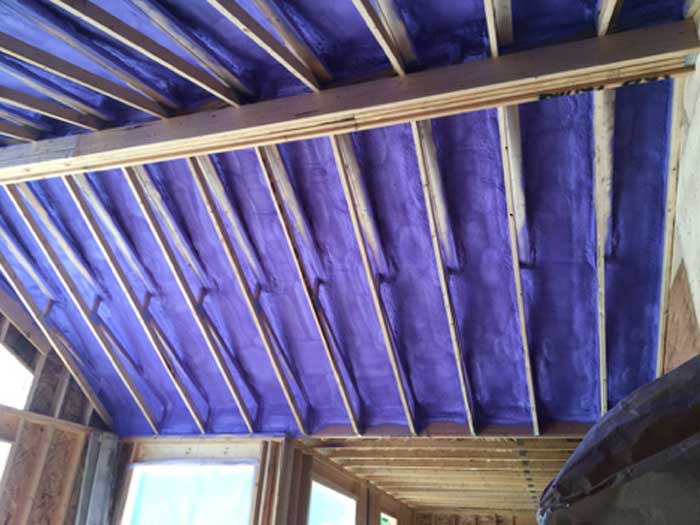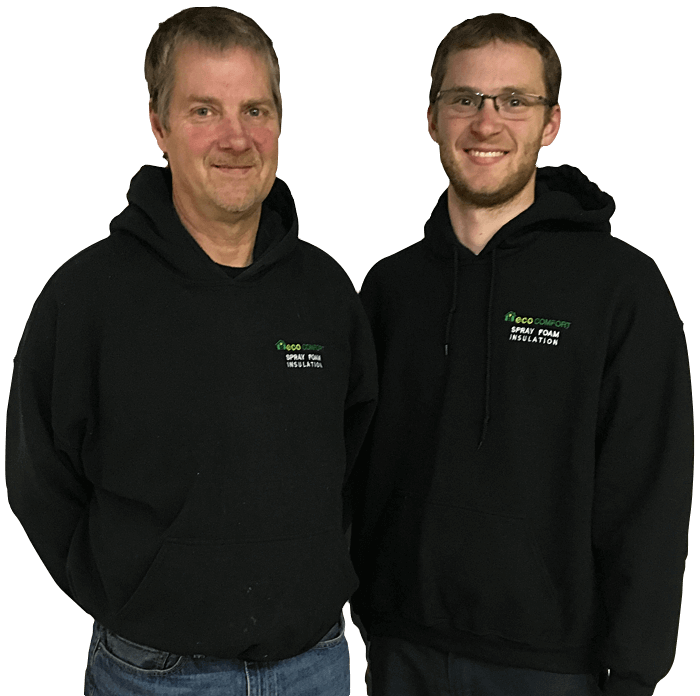Unvented Roof Assemblies
Unvented roof assemblies, such as conditioned attics and unvented cathedral ceilings, have become very common in all climate zones. These assemblies are created by eliminating ventilation openings and moving the thermal, moisture and air control boundaries to the plane of the roof deck.
Why Unvented Roof Assemblies?
Unvented roof assemblies have a number of advantages and virtually no draw backs.
Health & Comfort
In many houses air leakage between the living space and the attic is not properly controlled. Air-conditioning equipment, exhaust fans, ductwork, attic access hatches, recessed lighting and even plumbing & electrical penetrations create holes that connect the living space to the attic.
Pressures created by the mechanical equipment, as well as wind and temperature differences, cause air to move between these spaces leading to great energy waste and occupant discomfort.
This uncontrolled movement of air can also carry moisture to cold surfaces where it can condense. In hot humid climates outdoor air can condense on the air-conditioning equipment and ductwork typically located in attic spaces; in cold climates warm indoor air leaking into the attic can condense against the underside of the roof sheathing.
Contaminants such as mold due to the uncontrolled movement of moisture laden air can migrate from the attic into the living space.
In unvented roof assemblies the thermal, moisture and air control boundaries are moved to the roof deck so that the attic space is at the same condition as the living space and air movement between the two does not contribute to energy waste, occupant discomfort or contaminant problems.
Energy Savings
Air leakage is one of the top causes of inefficiency in a home. Using spray foam to create a perfectly sealed envelope and containing all of the mechanicals of the home within that envelope we can drastically improve the energy efficiency of the home. Furthermore, in many cases there isn’t enough physical space in the framing cavities to get enough r-value with traditional fiber products. Improperly insulated and sealed ceilings are the number 1 cause of heat loss in a home!
Durability
Openings in the soffits, gables, mushroom and ridge vents allow more than just air to enter the attic. In cold northern climates snow can be blown in through these openings, accumulating, melting and causing damage to the ceiling or creating the potential premature structural failure or mold growth inside the roof assembly. Wind driven rain can be blown in through these openings with similar results. Ventilation opening can also be inviting to all kinds of critters.
Unvented roof assemblies are not prone to these problems because the ventilation openings have been eliminated.
Why Use Closed-Cell Polyurethane Spray Foam?
Closed-cell spray foam (ccSPF) can be used to create an unvented roof assembly that works in both hot and cold climates. ccSPF is 100% air and vapour barrier with a very high r-value per inch. These properties are what makes spray foam great for walls and floors but these properties are critically important for ceilings that will see the most extreme heat and cold of any area in your home.

How Unvented Roofs Work
Controls Airflow
ccSPF is air impermeable, adheres well to almost all construction surfaces and expands to fill voids creating an air seal and eliminating air leakage. In cold climates it prevents warm, humid indoor air from reaching the back (underside) of roof sheathing where it can condense. In warm climates it prevents humid outside air that enters the roof due to natural and/or controlled ventilation from reaching the back of the roof sheathing.
Control Heat Flow
Closed-cell spray foam has exceptional thermal performance relative to other insulations (i.e. the highest R-value per inch.) ccSPF can be used to create a very compact roof assembly that meets or exceeds the code required thermal performance.
Control Vapor Diffusion
Spray foam insulation is a 100% vapour barrier. This means that water vapour cannot pass through the insulation to the underside of the roof sheathing. During the winter months if warm interior air come in contact with a cold surface like the underside of your roof deck, condensation will form, condensation formation leads to a host of other problems such as mold and rotting of framing members.
What about shingle life?
Certainly the most common question about Unvented Roofs is about shingle life. The fact of the matter is studies have shown that an unvented assembly will see approximately a 2 degree increase in shingle temperatures. This is a negligible difference that will not have an effect of the life of the shingles, in fact other factors like shingle colour and roof angle have a much more profound effect on shingle life.

What to Expect?
When you work with Ecocomfort Spray Foam, here’s what you can expect from our spray foam insulation installers:
-
Thorough Assessment: We conduct a detailed assessment of your property to understand your insulation needs and recommend the best solutions.
-
Customized Recommendations: Based on our assessment, we provide personalized recommendations for spray foam insulation that align with your budget and objectives.
-
Efficient Installation: Our installers ensure efficient and precise spray foam insulation installation, minimizing disruptions and maximizing insulation benefits.
-
Quality Assurance: We conduct post-installation inspections to ensure that the insulation meets our high quality and performance standards.

